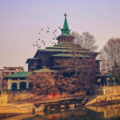Khanqah-e-Moula
Mosque in Srinagar, Jammu and Kashmir, India From Wikipedia, the free encyclopedia
The Khanqah-e-Moula, also known as Shah-e-Hamadan Masjid and Khanqah, is a Sunni mosque located in the Old City of Srinagar in Jammu and Kashmir, India. Situated on the right bank of the river Jhelum between the Fateh Kadal and Zaina Kadal bridges, it was built in 1395 CE, commissioned by Sultan Sikendar in memory of Mir Sayyid Ali Hamadani. It is held to be the first Khanqah—mosques associated with specific saints—in the Kashmir valley. It is one of the best examples of Kashmiri wooden architecture, and is decorated with papier mache.[1] The mosque structure is a Monument of National Importance.[2]
| Khanqah-e-Mu'alla | |
|---|---|
 The Khanqah on the banks of Jhelum River | |
| Religion | |
| Affiliation | Sunni Islam |
| Ecclesiastical or organizational status | Mosque |
| Status | Active |
| Location | |
| Location | Zaina Kadal, Old Srinagar, Srinagar District, Kashmir Valley, Jammu and Kashmir |
| Country | India |
Location of the mosque in Jammu and Kashmir | |
| Geographic coordinates | 34°05′28″N 74°48′28″E |
| Architecture | |
| Type | Mosque architecture |
| Style | Kashmiri |
| Founder | Sultan Sikandar |
| Completed |
|
| Specifications | |
| Height (max) | 38 m (125 ft) |
| Spire(s) | 1 (turret) |
| Official name | Khanqah of Shah Hamadan |
| Reference no. | N-JK-37 |
History
The mosque was commissioned by Sultan Sikandar Butshikan in 1395 CE in memory of the Islamic preacher Mir Sayyid Ali Hamadani. In recent centuries, some have claimed it was built on top of the ruins of a Hindu Kali temple.[3] The central figure involved in the widespread conversion to Islam in Kashmir. Also known as Shah-e-Hamadan (the King of Hamadan), the preacher came to Kashmir from the city of Hamadan, Persia in the 14th century. He is credited for the spread of Islam in Kashmir. In 1480 AD, the shrine was destroyed in a fire. The then-ruler, Sultan Hassan Shah, expanded its premises and rebuilt it. In 1731 CE, the Khanqah was again destroyed by fire and then rebuilt by Abdul Barkat Khan.
2017 fire
On 15 November 2017, a fire broke out in the shrine which damaged the spire of the building. Fire tenders were brought on the scene and they managed to arrest the spread of the fire which prevented any further damage to the building.[4] Restoration work was immediately started[5] and on 30 March 2018, a refurbished crown was successfully installed on the spire of the shrine.[6]
Gallery
- Sketch of the mosque, 1906
- The mosque's interior has intricate woodwork and is richly decorated with papier-maché, seen above in 2007; the wooden structure makes it prone to fires, the latest such incident occurring in 2017
- View of the Khanqah from the Jhelum river. On the bank saffron marks indicate the veneration of the place where once a Kali temple existed.
See also
References
External links
Wikiwand - on
Seamless Wikipedia browsing. On steroids.




